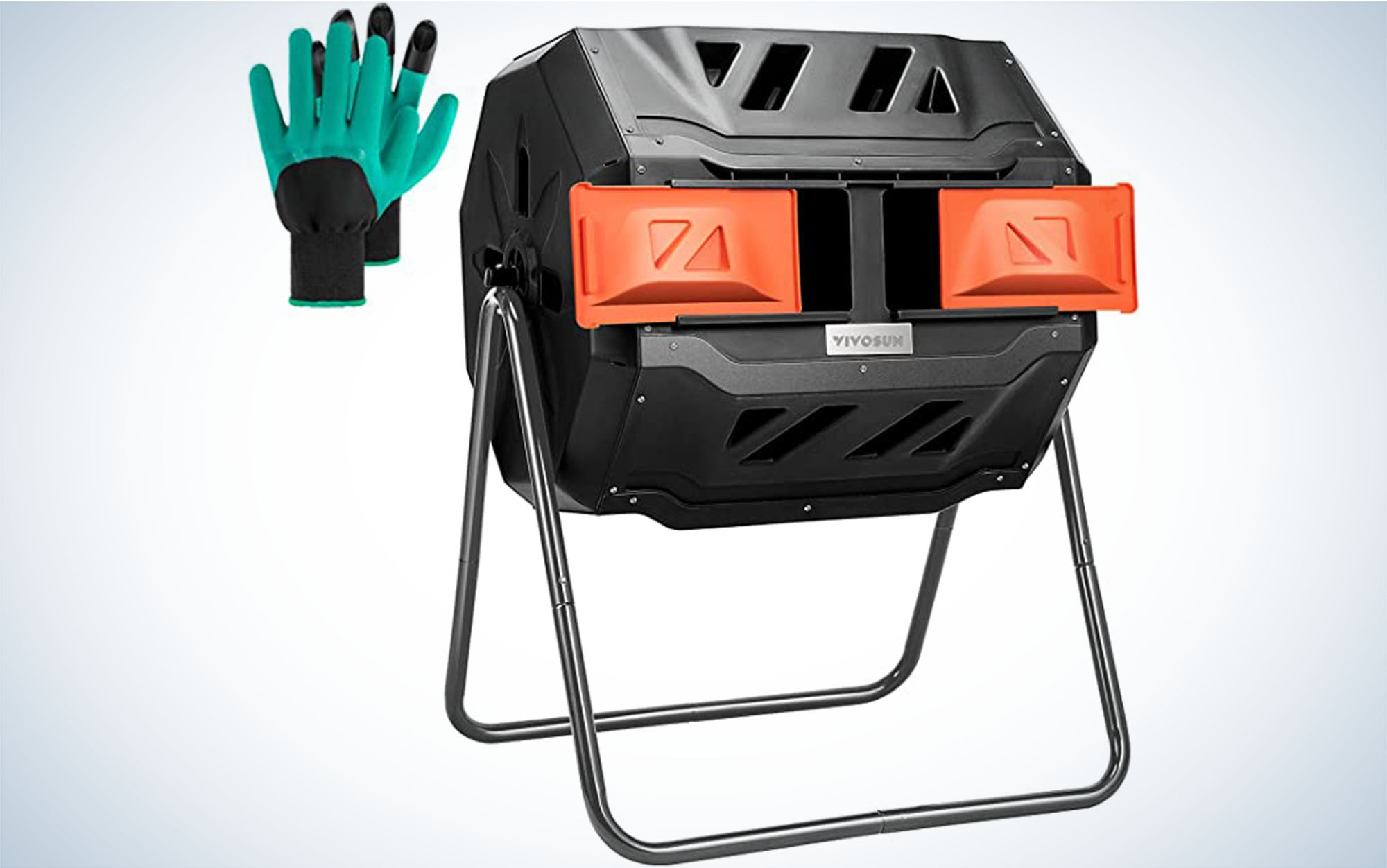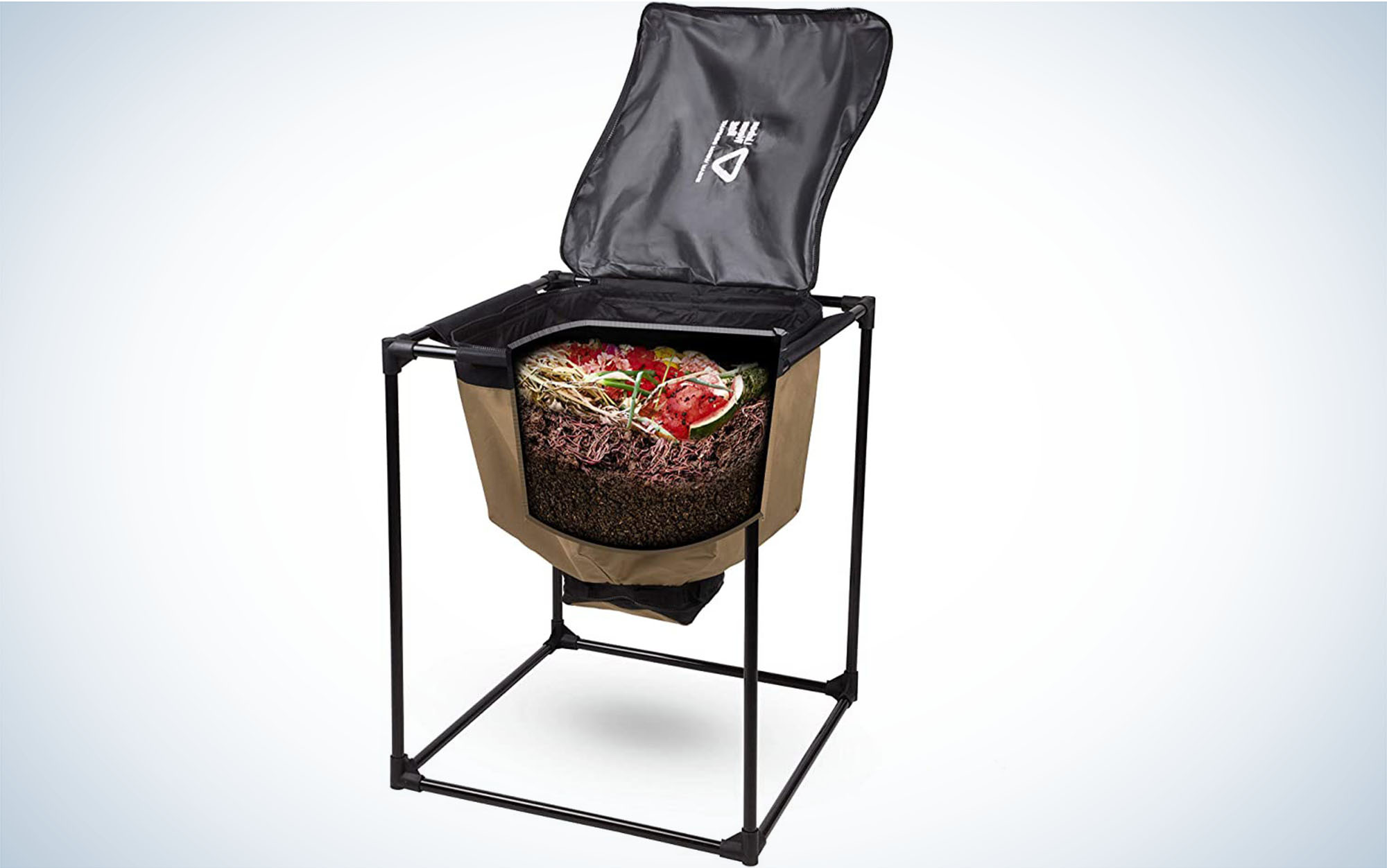We may earn revenue from the products available on this page and participate in affiliate programs. Learn More ›
Published Mar 29, 2023 12:16 PM
Well-aged compost does wonderful things for soil. It brings microbial life, helps soil retain moisture, and improves soil structure. But, compost that isn’t well-aged can rob nitrogen from your plants. Anaerobic compost, when not done properly, can smell terrible and house bad bacteria. An easy way to avoid anaerobic compost and make sure your compost is fully broken down is to use a compost tumbler. These easy-to-use tools make the work of turning over a compost pile much easier. You just crank the handle to aerate and move the top layer—which is less broken down—to the bottom. Here’s a look at the best compost tumblers as well as some specialized composters.
How I Chose the Best Compost Tumblers
I have a 2,000-square-foot garden that’s a mix of raised and in-ground, no-till garden beds. I use about two yards of compost each season to add a fresh layer of organic matter. That compost is a mix of my homemade compost and compost from a local supplier. I used my experience making compost in a variety of methods—hugelkultur, bokashi, vermicompost, and a standard pile—to choose great tumblers and composters for your home garden.
Best Compost Tumblers: Reviews & Recommendations
Best Overall: Jora Composter 270
Key Features
- Two champers
- Rodent proof
- Insulated
- Volume: 70 gallons
- Weight: 86 pounds
- Price: $584
Pros
- Can compost most food waste
- Metal construction
Cons
If you really want the best compost tumbler, the Jora is the one you need to take a look at. It’s made from metal—most tumblers are plastic—and it’s highly insulated to retain heat, which means you get finished compost faster. It’s also rodent proof, so you don’t have to worry about creating mice habitat in your yard.
To use the tumbler, add your kitchen or yard waste to one side and then give it a spin. It’s as easy as that. When it reaches capacity, you can start using the second chamber while you let the first chamber break down for a few weeks. Before using your compost, inspect it to see if it’s fully broken down. You shouldn’t see big chunks of material, just uniform black gold. If your compost needs more time, give it a tumble and then check back in a few weeks. The compost you make can be used for compost tea or added straight to your garden.
Best Value: VIVOSUN Compost Tumbler
Key Features
- Two chambers
- Volume: 43 gallons
- Dimensions: 26.26 x 23.6 x 36.5 inches
- Weight: 21.67 pounds
- Price: $120
Pros
- Great for small gardens
- Light
Cons
If you need a small tumbler that will make great compost, then you should take a look at the VIVOSUN Compost Tumbler. It has two chambers, so you can fill one up and let it finish processing while you work on filling the other chamber. It’s easy to move thanks to its sub-25-pound weight. It’s also vented for added aeration and to release gasses created as a byproduct of composting. The list price is $120, but you can often find them on Amazon for under $110, which makes them an excellent value.
Best Countertop: All Seasons Indoor Composter Starter Kit
Key Features
- Volume: 5 gallon
- Creates a microbial-rich compost tea and compost
- Can compost meat, dairy, and bones
Pros
- Can compost food scraps that other methods cannot
- Creates a versatile compost
Cons
- Can smell stronger than aerobic compost
Earlier I mentioned that when anaerobic composting isn’t done correctly, it can create a foul-smelling and harmful product. But, when done properly, this process ferments your food scraps into one of the best composts available.
The key is using the included bokashi starter, which speeds up the process, outcompetes bad bacteria and reduces odors. The process for using this kit is pretty simple: add food scraps, add some bokashi starter, and occasionally drain the liquid. When the bin is full, set it aside for a few weeks until the compost is fully broken down. Then it can be used for making compost tea, foliar sprays, or directly added to soil.
Best for Vermicomposting: Urban Worm Bag
Key Features
- Dimensions: 27.5 x 27.5 x 31 inches
- Price: $140
Pros
- Easy to assemble
- Produces a highly versatile compost
- Makes great use of food scraps
- Easier to use than stacked worm composters
Cons
- Requires more maintenance than a standard compost pile
Vermicompost is the most beneficial compost to make on a small scale. It’s packed full of micronutrients, microbial life, and a little bit of plant-available nitrogen. You can add worm casting directly to soil, potting mix, and seed starting mix. You can also mix it with rainwater to make a foliar spray or soil drench. Not to mention that your worms will eat up a lot of your kitchen and yard waste.
The best vermicomposter for home gardeners is the Urban Worm Bag. That’s because it’s easy to remove castings and load in scraps. It’s perfect for keeping in a garage or shaded place outdoors—worms like to be kept from 50 to 80 degrees.
To get your worm farm going, set up your Urban Worm Bag (no tools required), then add two bricks of coco coir and 1,000 red wiggler worms. Instead of coco coir, you can use shredded cardboard or newspaper as a bedding. Also, keep in mind that you shouldn’t feed your worms a lot when you first start. Feed them or two cups of food scraps per week until you see that they’re eating everything you add. Then you can begin adding more food. Be sure to add more bedding each time you feed your worms. The Urban Worm Company recommends adding two times the volume of bedding to food. So, add two cups of bedding if you add one cup of food.
DIY
Making homemade compost doesn’t have to be complicated, and it doesn’t require one of the best compost tumblers. You can take a pile of wood chips, turn it every couple of months, and a year later you’ll have a pile of compost. If you want to take that pile and make it even better, you can add different types of organic matter like grass clippings, leaves, and vegetable scraps. You can also make a simple frame from shipping pallets to house your pile.
How to Choose a Compost Tumbler
Materials
The Jora composter is four times the price of other composters because it’s made from metal and is well insulated. That means it’s more durable and produces a finished product faster. Plastic tumblers like the VIVOSUN are cheaper and lighter but can break down when exposed to sunlight over the years.
Capacity
Compost tumblers are available in a wide range of volumes, and you should choose the size that best fits the amount of food and yard waste you produce. For reference, a 70-gallon compost tumbler is a good size for a family of four. A 30- to 40-gallon tumbler is ideal for one to four-person households.
What You Can and Cannot Compost in a Tumbler
Can
- Food Scraps (raw, cooked, fried, and smoked)
- Meat and Bones (bones will be cleaned but not composted)
- Fish and Bones (bones will compost)
- Seafood
- Vegetables (raw and cooked)
- Eggs and Shells
- Bread
- Fruit
- Coffee grounds and filters
- Teabags and tea leaves
- Paper
- Egg Cartons (torn up into small pieces)
Cannot
- Cigarette butts and cigarette ashes
- Chewing gum
- Tinfoil and other metals
- Rubber and plastic items
- Vacuum cleaner bags
- Milk or juice cartons
- Sawdust from treated wood
- Hardwood because it takes too long to breakdown
Tumbler Alternatives
You don’t need a large compost tumbler to make good use of food waste and benefit your garden. Alternatives like a worm farm or bokashi bucket are excellent alternatives to making big batches of traditional compost.
FAQs
Q: Which is better, a compost bin or tumbler?
A compost bin takes more physical work to rotate, but you can make a bin of a much larger capacity than what is practical for a tumbler. A tumbler is easier to use, but is limited in its size.
Q: What not to put in a compost tumbler?
Do not put cigarettes, gum, metal, plastic, rubber, milk cartons, wood (takes too long to break down), liquid, milk, diapers, and cat litter in your compost tumbler.
Q: Are compost tumblers worth it?
If you want to make good use of your food waste and provide your garden with quality organic matter, then a compost tumbler is absolutely worth it.
Final Thoughts
Composters range from highly-effective garden tools to trendy yet ineffective ones. To avoid the hype, consider your composting needs and choose the best compost tumbler that matches your budget and capacity needs.



